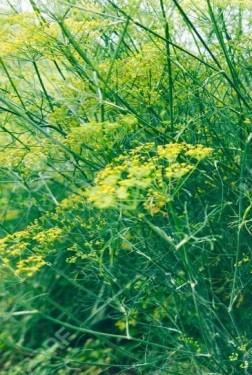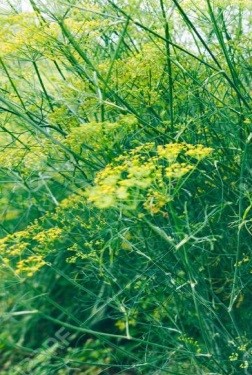Area
In the wild it grows on the shores of the Mediterranean. Grown in the republics of Moldova and Ukraine (Khmelnitsky region), Voronezh region, Krasnodar region and the North Caucasus.
Botanical description of the plant
Common fennel (pharmacy dill) - Foeniculum Vulgare Mill. (Foeniculum Officinalis All.) Belongs to the family of celery - Apiaceae (umbelliferae - Umbelliferae). Perennial (grown biennially on plantations), a herbaceous plant reaching 90-200 cm in height. Stems erect, versatile and branched. The leaves are separated three or four times in a row and are arranged in a row on the stem with the stalk. The leaf segments are thinly linear or fibrous. The flowers are small, yellow, clustered in a complex umbrella. The umbrella will not have wrapping and wrapping leaves. The calyx leaf is very small, the corolla is 5-lobed, the maternal node is two-chambered, located below. The fruit is a double pistachio. It flowers in July-August and ripens in September.

Medicinal properties
The fruit contains 3-6.5% of essential oil, up to 20% of fat and protein. According to XI DF, the essential oil content of the fruit should not be less than 3%. The essential oil is extracted from ripe and crushed fruit with the help of water vapor. It is a colorless, slightly pale yellow, volatile, reminiscent of the smell of fennel oil, a clear liquid that first tastes bitter-sweet, then sweeter. Density 0.960-0.979, refractive index 1,527-1,538, at temperatures below + 10 ° C the crystalline part of the essential oil (stearoptene) - anethole is released. The essential oil contains 50-60% anethal, 10-20% fenxon ketone, up to 10% methylhavicol, small amounts of anise aldehyde and anise acid, pinene, fellandrene, camphene and other compounds.
Pharmacy dill root was found to contain 5 coumarin compounds, 2 of which were bergapten and umbelliferon. To be used. The fruits and preparations of pharmacy dill are used in gastrointestinal diseases and flatulence (flatulence, abdominal distension) as a expectorant, laxative and hand-held drug in inflammation of the upper respiratory tract. Sometimes the fruit is also used in diseases of the gallbladder and kidney stones. Essential oil is used in pharmacy to improve the taste of mixtures. Fruit powder (powder) is a complex powder (powder) of licorice root, which is used as a laxative. In addition, the fruit is included in hand-driving, laxative teas. Dill juice is made from the essential oil of pharmacy dill.
Growing technology
In the conditions of irrigated agriculture, the cultivation of medicinal dill in large areas and the cultivation of more raw materials is one of the most pressing issues facing specialists. It is known that the root system of medicinal dill is arrow-rooted and reaches a deeper (55-60 cm) layer of soil than other medicinal plants, so it is recommended to allocate the most fertile, moderately mechanical, well-watered, fall and plowed lands. is done. Medicinal dill is a warm and fertile plant, its growing season lasts 120-140 days. Plant lands are plowed to a depth of 25-28 cm in early autumn. Before driving, of course, 15–20 tons per hectare of local fertilizers and 50 kg of superphosphate fertilizers are fed. For planting medicinal dill in early spring the soil is leveled with a harrow and a hoe. Cleared from the roots of weeds. Sowing is carried out in the first 10 days of March with vegetable seeders at row spacing of 60 cm. The seeds are planted in a moist layer of soil to a depth of 3-4 cm, and the norm for sowing on 1 hectare of land is 8-10 kg. Before sowing, the seeds are sown in a mixture of dry and fine wood chips, manure or sand so that they fall flat on the soil surface. When medicinal dill is planted in the fall, some of the seeds sprout and overwinter in the form of leaves. Planted in early spring, they germinate in 8-9 days. After the grass sprouts, the seedlings are loosened with the help of cultivators and weeded by hand. During the growing season, the plant is cultivated 3-4 times in between and weeded 2-3 times, leaving 10-12 plants per meter of land. As a result of accumulation of medicinal dill, it is impossible to process it. Medicinal dill is a much more demanding plant to fertilizer. Fertilizing them depends in many ways on the type of crop of the past, the amount of fertilizer and soil fertility. These crops begin to grow rapidly in early spring. They are advised to take into account the amount of yield, past crop and soil-climatic conditions when determining the rate of fertilization. The first feeding of the plant begins with the application of 50 kg of nitrogen and 20 kg of potassium fertilizers per hectare after the emergence of grass. Medicinal dill is very demanding on nutrients, especially this condition can be observed before flowering. Therefore, in the flowering phase of the second feeding is recommended to give 50 kg of nitrogen per hectare, 30 kg of phosphorus and potassium fertilizers.
Fertilizers applied during the flowering phase allow the plant to grow well and take strong root. Feeding should be done before each watering.
In the first year it is watered 6–7 times, taking into account the weather and soil moisture. In the second and subsequent years, the areas planted with medicinal dill are fed with nitrogen fertilizer at the rate of 50 kg per hectare twice before the flowering phase.





